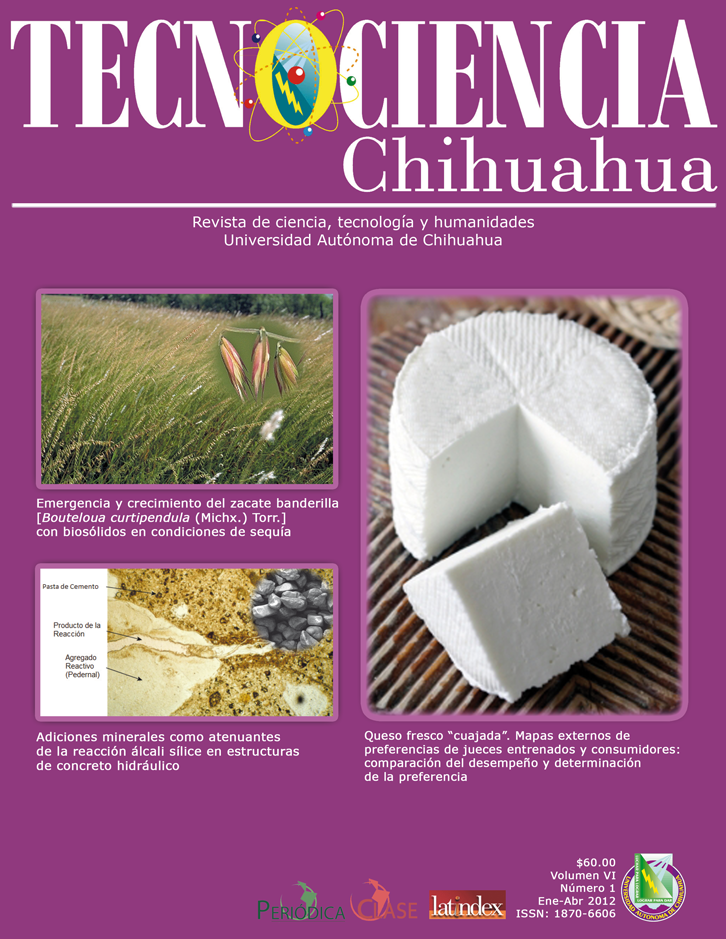Adiciones minerales como atenuantes de la reacción álcali sílice en estructuras de concreto hidráulico
Mineral admixtures as attenuators of the alkali silica reaction in Portland cement concrete structures
Resumen
La reacción álcali sílice (RAS) afecta la durabilidad de estructuras de concreto hidráulico, ocasionando deterioros prematuros en el concreto hecho con agregados pétreos reactivos. El objetivo fue evaluar el potencial de la RAS del concreto hidráulico elaborado con agregados pétreos de dos regiones de Chihuahua para proponer medidas preventivas contra la RAS. Se discuten conceptos básicos de la reacción y mecanismos de expansión, condiciones que dan lugar al desarrollo y sustentabilidad de la RAS en el concreto. Se evaluaron diferentes mezclas de mortero mediante la norma ASTM C1260. Se consideraron dos tipos de cemento que comúnmente se comercializan (alto y bajo en álcalis) y dos tipos de adiciones minerales (micro sílice y ceniza volante clase F) para elaborar barras de mortero y medir su expansión a los 16 días de su elaboración, colocadas a una temperatura de 80 °C y en una solución de hidróxido de sodio. Para la determinación de la expansión se utilizó el comparador de longitudes (ASTM C490). En el caso de la arena de Ciudad Juárez combinada con 15% de micro sílice y con 25% de ceniza volante clase F, resultó no reactiva, con límites de expansión menores al 0.1%, que es el límite máximo permisible. De manera análoga, la arena del río Satevó, combinada con 5% de micro sílice y 20% de ceniza volante clase F, resultó no reactiva. Se concluye que estas proporciones son recomendables para su aplicación en estructuras de la ciudad de Chihuahua.
Abstract
The alkali silica reaction (ASR) affects the durability of Portland cement concrete structures. It causes premature damages in structures made with Portland cement concrete in which is involved reactive aggregates. The objective of this research was to evaluate the potential of the ASR of Portland cement concrete with reactive aggregates of two regions of Chihuahua, in order to give alternatives to prevent the ASR were proposed. The issues discussed include basic concepts of reaction and expansion mechanisms, conditions that lead to the development and sustainability of ASR in the concrete. Several mixtures were evaluated by ASTM C1260. There were evaluated two types of cements that are commonly marketed (high and low in alkalis) and two types of mineral admixtures (silica fume and class F fly ash) were used to produce mortar bars samples. These samples were placed at a temperature of 80 °C and into a solution of sodium hydroxide for 16 days. After that, the expansion was measured (ASTM C490). In the case of Juarez city sand, it was mixed with 15% silica fume and 25% fly ash class F; the expansion was lower than 0.1%, which is the maximum allowable limit to be considered as reactive. In a similar way, Satevo river sand mixed with 5% silica fume and 20% fly ash class F was not reactive. It was concluded that these proportions are recommended for using in Portland cement structures.
Keywords: mortar, expansion, silica fume, fly ash class F.
Citas
American Society for Testing and Materials. 2007. ASTM C1260-07. Standard test method for potential alkali reactivity of aggregates (mortar-bar method). Vol. 4.02. Annual Book of Standards. Construction.
American Society for Testing and Materials. 2009. ASTM C511-09. Standard Specification for Mixing Rooms, Moist Cabinets, Moist Rooms, and Water Storage Tanks Used in the Testing of Hydraulic Cements and Concretes. Vol. 4.01. Annual Book of Standards. Construction.
American Society for Testing and Materials. 2011. ASTM C305-11. Standard Practice for Mechanical Mixing of Hydraulic Cement Pastes and Mortars of Plastic Consistency. Vol. 4.01. Annual Book of Standards. Construction.
American Society for Testing and Materials. 2011. ASTM C490/c490-11. Standard Practice for Use of Apparatus for the Determination of Length Change of Hardened Cement Paste, Mortar, and Concrete. Vol. 4.01. Annual Book of Standards. Construction.
Hasparyk, N. P., P. J. M. Monteiro & H. Carasek. 2000. Electronic microscopy to identify ASR. ACI Journal Materials 97(4): 486-492.
Master Builders Technologies. 2004. Recomendaciones sobre la aplicación de microsilice Rheomac SF 100. Latinoamérica. MBT México (MBT).
Nochaiya, T., W. Wongkeo & A. Chaipanich. 2010. Utilization of fly ash with silica fume and properties of Portland cement–fly ash–silica fume concrete. Fuel 89(1): 768–774. https://doi.org/10.1016/j.fuel.2009.10.003
Olague, C. O. 2003. Caracterización físico química de agregados para concreto hidráulico. Colección de Textos Universitarios. Universidad Autónoma de Chihuahua.
Olague, C. O., R. Bojórquez & P. Castro. 2001. Application of a methodology for evaluating concrete pavements with durability criteria. International Congress of International Road Federation. Paris France.
Shon, G. S., D.G. Zollinger & S. L. Sarkar. 2002. Evaluation of modified ASTM C1260 accelerated mortar bar test for alkali- silica reactivity. Cement and Concrete Research 32(1):1981–1987. https://doi.org/10.1016/S0008-8846(02)00903-1
Šachlová, Š., R. Pøikryl & Z. Pertold. 2010. Alkali-silica reaction products: Comparison between samples. Materials Characterization 61(1): 1379-139. https://doi.org/10.1016/j.matchar.2010.09.010
Derechos de autor 2020 TECNOCIENCIA Chihuahua

Esta obra está bajo licencia internacional Creative Commons Reconocimiento-NoComercial 4.0.









